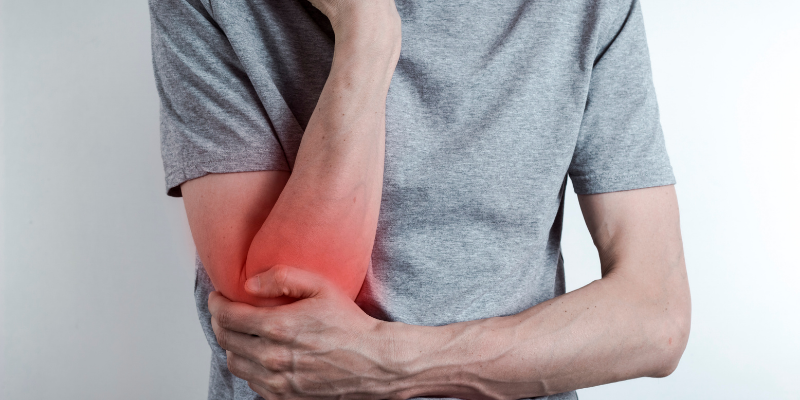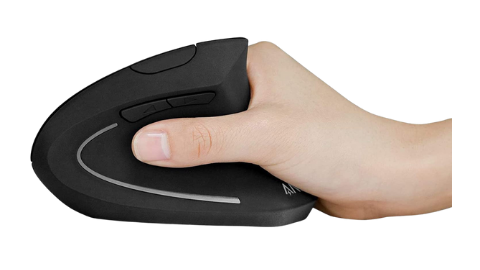Tennis Elbow also referred to as Lateral Epicondylitis, is a common injury afflicting tennis players, desk jockeys, and nonathletic people. Finding an effective at-home treatment for tennis elbow discomfort can be time-consuming with the abundance of recommendations you can find online.
Reassured, in this blog post, you’ll find numerous techniques that are scientifically proven to work to relieve pain.
[ez-toc]
At-Home Treatment For Tennis Elbow Pain
When someone gets a tennis elbow, the tendons of the lateral part of the elbow get overused, causing soreness.
Instead of thinking of tennis elbow as tendinitis, Paul Ingraham from PainScience.com says,
You should think of it as a “tendinopathy,” which is Latin for “something wrong with a tendon.”
Tendinopathy is a deliberately broad term used because we really don’t know what’s going on. Tendinopathy refers to “any painful condition occurring in and around tendons in response to overuse,” but “recent basic science research suggests little, or no inflammation is present in these conditions.”
Tennis elbow symptoms can gradually develop over time, starting with general soreness and tenderness around the outside of the elbow. Eventually, this leads to tight forearm muscles (also called the extensors).
If left untreated, there’s a strong possibility you won’t be able to straighten your arm when you wake in the morning, without extreme pain and discomfort. Besides, performing simple tasks can become challenging and frustrating, such as turning a doorknob or shaking hands.
Don’t fret!
I’m going to show you how to get rid of tennis elbow at home in just ten minutes.

If you suspect you have tennis elbow, take a break from using your arm, and do whatever you can to move it as little as possible.
Many people try to tough it out and work through the pain. They continue to use their arm despite the unbearable discomfort.
If this pain persists for three months, it’s gotten into the chronic phase, and now you could be dealing with tennis elbow for a LONG time.
However, with proper care, your tennis elbow can go away quickly in a matter of weeks.
Self-Massage Forearm Flexors and Extensors
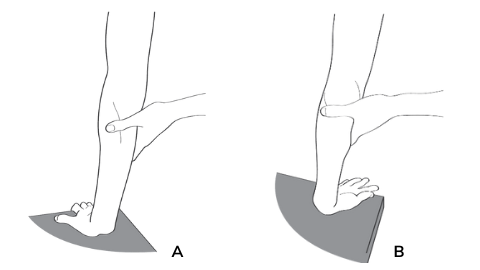
It’s best to self-massage without a lubricant because you’ll also be able to engage the tissue.
To begin, roll up your sleeve and extend your hand back, placing your palm on a flat surface like a table. (See image A)
Grip your forearm by placing your thumb on the flexor side and the fingers near the elbow.
Slowly glide your thumb and fingers down toward the table. Repeat ten times.
Now, turn your hand around and place the top of your hand down onto the table. (See image B) Grip the forearm with the thumb on the extensor side and the fingers near the elbow.
Slowly glide the thumb down toward the table. Repeat ten times.
If you don’t feel confident in massaging your forearm yourself, I suggest scheduling an appointment with a professional massage therapist.
Wrist Stretches: Flexion and Extension
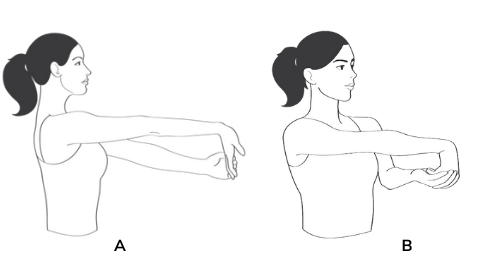
Stretching your wrist can help to elongate the tight forearm flexor muscles. (See image A)
How to Do It
Bend and stretch your wrist as far back as you can, providing slight pressure with your other hand.
Hold for 2 seconds. Repeat ten times.
Now, you’ll want to stretch the forearm extensors. (See image B)
Bend your wrist in the other direction so that your palm is facing down.
Add a slight pressure downward for 2 seconds. Repeat ten times.
Tennis Elbow Exercise Using a Theraband FlexBar
The FlexBar is a flexible, durable resistance device that can help you strengthen your forearm muscles.
It has been clinically researched and proven to reduce elbow pain by 81 percent. It increases strength in the tendons by 72 percent in tennis elbow patients.
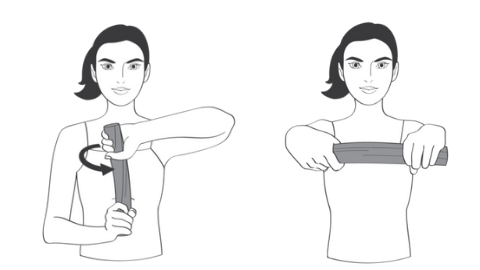
Hold the FlexBar in your involved hand (in the illustration above, it is the right hand) in full wrist extension.
Grab the other end of the FlexBar with your uninvolved (left) hand with the palm facing out,
Twist the FlexBar with your uninvolved wrist while holding the involved wrist in extension.
Extend both elbows and bring both arms in front of you while maintaining the twist in the FlexBar, by holding the uninvolved wrist in full flexion and the involved wrist in full extension.
Slowly let the FlexBar untwist while moving the involved wrist into flexion.
Golfer’s Elbow Exercise Using a Theraband FlexBar
Also known as medial epicondylitis, Golfer’s Elbow is an overuse injury to the forearm flexor tendons that causes a tightening of the associated muscles.
And, no, you don’t need to be hanging around the nineteenth hole with Tiger to get Golfer’s elbow.
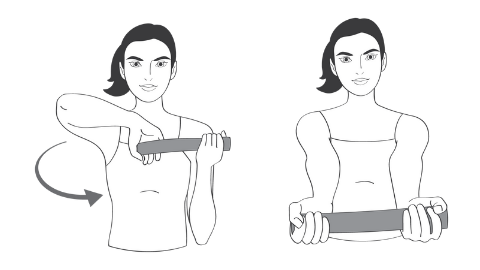 What Causes It?
What Causes It?
Typically, overuse causes Golfer’s elbow.
Gripping your smartphone for long periods and using it as a stress ball could irritate the tendons and associated musculature.
It’s best to get a Bluetooth headset.
Begin with a red Theraband FlexBar.
Grasp one end of the FlexBar with your involved wrist and elbow flexed (the left arm in the illustration shown here).
Grasp the FlexBar with your opposite hand, facing away and pointing down. Then twist the FlexBar with your uninvolved side, keep your involved wrist flexed.
Extend both elbows, keeping your involved wrist flexed. Slowly extend the problematic wrist while holding the uninvolved wrist steady.
Repeat fifteen times. Do three sets.
Other Tennis Elbow Tips
#1: Ice It!
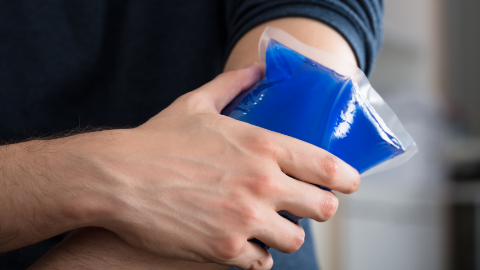
It would help if you acted fast, like Superman or Superwoman. Once you feel the pain, be proactive.
Use an ice pack or a cold pack for about 10 to 15 minutes at a time
Repeat up to two or more times a day.
Icing your elbow can speed the recovery and reduce swelling and inflammation.
Tip: If you’re using straight ice, then place a thin cloth on your skin. Keep the ice on your elbow until the pain subsides or until it melts.
If you dislike ice, then use a warm, moist cloth or soak in a hot bath. Trust your gut. If the ice makes you cringe, skip it, and take a dip in the tub. Just make sure the water isn’t scalding hot.
#2: Elbow Brace
The elbow braces work by compressing the upper forearm and absorbing the forces transmitted through the soft tissues. Using a tennis elbow brace spreads the pressure throughout your arm instead of putting it all on the tendon, allowing the injured area to recover faster.
#3: Upgrade Your Computer Mouse
If you find your computer mouse aggravates your symptoms, you might need to consider changing to an ergonomic mouse.
An ergonomic mouse places your wrist and forearms into a more naturally aligned posture that helps to reduce the amount of muscle activity required to use your mouse.
A vertical mouse will help to put your wrist in a neutral posture. This change in working position will help to alleviate some of the pain symptoms you might be experiencing.
So there you have it, at-home treatment for tennis elbow pain that works.
